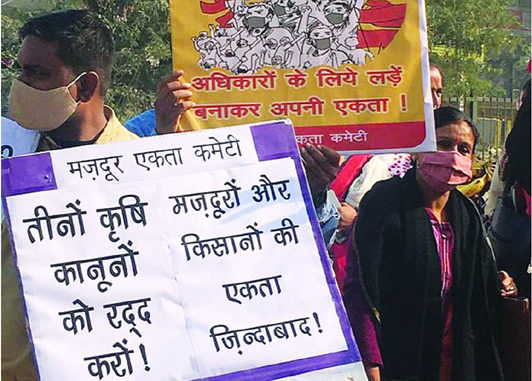
Agriculture is the primary source of livelihood for about 58% of India’s population. Gross Value Added (GVA) by agriculture, forestry and fishing was estimated at Rs. 19.48 lakh crore (US$ 276.37 billion) in FY20 (PE). Growth in GVA in agriculture and allied sectors stood at 4% in FY20. The agriculture, forestry and fishing gross value added (GVA) growth is likely to be 3% in the second quarter of FY21.
The Indian food industry is poised for huge growth, increasing its contribution to world food trade every year due to its immense potential for value addition, particularly within the food processing industry. Indian food and grocery market is the world’s sixth largest, with retail contributing 70% of the sales. The Indian food processing industry accounts for 32% of the country’s total food market, one of the largest industries in India and is ranked fifth in terms of production, consumption, export and expected growth.
Essential agricultural commodities export for the April-September period of 2020 increased by 43% to Rs. 53,626 crore (US$ 7.3 billion) over Rs. 37,397 crore (US$ 5.1 billion) in the same period last year.
Market Size
During 2019-20* crop year, food grain production was estimated to reach a record 295.67 million tonnes (MT). In 2020-21, Government of India is targeting food grain production of 298 MT.
Production of horticulture crops in India was estimated at a record 320.48 million metric tonnes (MMT) in FY20 as per second advance estimates. India has the largest livestock population of around 535.78 million, which translates to around 31% of the world population. Milk production in the country is expected to increase to 208 MT in FY21 from 198 MT in FY20, registering a growth of 10% y-o-y.
Sugar production in India reached 26.46 MT between October 2019 and May 2020 sugar season according to Indian Sugar Mills Association (ISMA).
India is among the 15 leading exporters of agricultural products in the world. Agricultural export from India reached US$ 38.54 billion in FY19 and US$ 35.09 billion in FY20. The total agricultural export was US$ 10.40 billion between April and October 2020.
The organic food segment in India is expected to grow at a CAGR of 10% during 2015-25 and is estimated to reach Rs. 75,000 crore (US$ 10.73 billion) by 2025 from Rs. 2,700 crore (US$ 386.32 million) in 2015.
Small and marginal farmers own just 47.3% of crop area, shows farm census
Small and marginal farmers with less than two hectares of land account for 86.2% of all farmers in India, but own just 47.3% of the crop area, according to provisional numbers from the 10th agriculture census.
In comparison, semi-medium and medium land holding farmers owning between 2-10 hectares of land account for 13.2% of all farmers, but own 43.6% of crop area, the survey showed.
Overall, the survey showed that while Indian farms became more fragmented between 2010-11 and 2015-16, holdings continue to be inequitably distributed.
During this period the proportion of small and marginal farmers grew from 84.9% to 86.2%, while the total number of operational holdings grew from 138 million to 146 million.
The total area under farming, however, fell from 159.6 million hectares in 2010-11 to 157.14 million hectares in 2015-16.
The existence of a large number of small and marginal farmers, close to 126 million according to the survey, means it is challenging for the government’s extension arms to reach them with new technology and farm support schemes.
Further, these 126 million farmers together owned about 74.4 million hectares of land —or an average holding of just 0.6 hectares each—not enough to produce surpluses which can financially sustain their families, explaining the rising distress in Indian agriculture.
Between 2010-11 and 2015-16, the number of small and marginal farms rose by about 9 million, the survey showed. For all farmers put together, the size of average land holding declined from 1.15 hectares in 2010-11 to 1.08 hectares in 2015-16.“The rise in the number of small and marginal farmers signifies that the rest of the economy is unable to absorb the surplus… India has to live with its small-sized farms for the next two decades and the way out is to provide them access to the best technology and markets, the way China did it,” according to Ashok Gulati, an agriculture chair professor at the New Delhi-based Indian Council for Research in International Economic Relations.
State-wise data from the survey showed that Uttar Pradesh accounted for the largest number of operational holdings or farmers at 23.8 million followed by Bihar (16.4 million) and Maharashtra (14.7 million).
Among operated or farmed areas, Rajasthan topped the list with 20.9 million hectares, followed by Maharashtra (19.9 million hectares) and Uttar Pradesh (17.45 million hectares).
The survey also showed that the proportion of farms that are operated by women rose from 12.8% in 2010-11 to 13.9% in 2015-16, signifying that more women are managing farm operations.
Deepening agrarian crises
From 1951 to 2011, the percentage of India’s population dependent on agriculture to make a living reduced from over 70 percent to 48 percent. But at the same time, the number of families dependent on agriculture and the total number of holdings have increased. Between 2001 and 2011, the number of farmers reduced by 85 lakh, but the number of farm labourers increased by 3.75 crore, according to the State of Rural and Agrarian India Report 2020.
For the census, the government classifies land holdings into five groups: marginal (with holdings of less than one hectare), small (1-2 hectares), semi-medium (2-4 hectares), medium (4-10 hectares), and large holdings of over 10 hectares. As per the agriculture census of 2015-16, the majority of land holdings in India — 86 percent — are small and marginal. They are less than two hectares in size, and these households’ incomes are already below what they spend on consumption expenditure.
In Punjab, according to census data from 2015-16, 33.1 percent of land holdings are small and marginal, while 33.6 percent are semi-medium. In Haryana, 68.5 percent of holdings are small and medium.
In India in 2015-16, 92.3 percent of operational land holdings held by scheduled castes were in small and marginal categories. In Punjab, like elsewhere, the upper caste Sikh Jat dominate farm land ownership with only 3.5 percent of private farmland (land titles) being owned by Dalits or scheduled castes. The majority, 57.8 percent of operational (including leased) land holdings held by scheduled castes, were small and marginal.
According to the 2020 report, after the onset of the Green Revolution in the late 1960s, between 1970 and 2010, the area collectively under rice and wheat increased from 47.2 percent of the total cropped area to 80.3 percent in Punjab. Even small cultivators in Punjab and Haryana have switched from diverse crops, such as millets, to monocultures of paddy and wheat, marked by an increased reliance on chemical inputs, hybrid seeds, and an excessive extraction of groundwater.
Over the years, the soil and water conditions have worsened. Between 1970 and 2005, there was a 75 percent decline in the yield of grain per nitrogen-phosphorus-potassium fertilisers used. There’s also been a decline of 0.33 metres per annum in the water table in Punjab, Haryana and Rajasthan. This impacts all categories of cultivators and has broadened the base of the agitation, argued Shreya Sinha, a postdoctoral researcher studying agrarian change, in the India Forum. The Zameen Prapti Sangharsh Committee, a union working for access of Dalit cultivators to reserved common lands, has also joined the agitation, reported Hindustan Times.
Some farmers grow other crops, such as cotton and maize, in the kharif season, but with no public procurement of these crops at assured prices, they view paddy and wheat as the only crops where both markets and prices are assured. In 2019-20, the government procured 226.5 lakh tonnes of paddy and 201.1 lakh tonnes of wheat, according to the Indian Express, from Punjab and Haryana, worth close to Rs 80,293.2 crore.





Be the first to comment